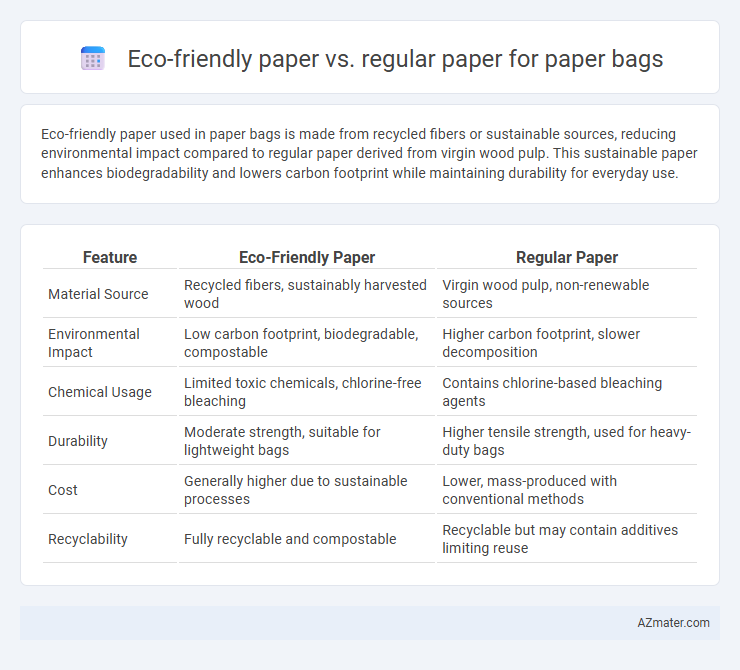Eco-friendly paper used in paper bags is made from recycled fibers or sustainable sources, reducing environmental impact compared to regular paper derived from virgin wood pulp. This sustainable paper enhances biodegradability and lowers carbon footprint while maintaining durability for everyday use.
Table of Comparison
| Feature | Eco-Friendly Paper | Regular Paper |
|---|---|---|
| Material Source | Recycled fibers, sustainably harvested wood | Virgin wood pulp, non-renewable sources |
| Environmental Impact | Low carbon footprint, biodegradable, compostable | Higher carbon footprint, slower decomposition |
| Chemical Usage | Limited toxic chemicals, chlorine-free bleaching | Contains chlorine-based bleaching agents |
| Durability | Moderate strength, suitable for lightweight bags | Higher tensile strength, used for heavy-duty bags |
| Cost | Generally higher due to sustainable processes | Lower, mass-produced with conventional methods |
| Recyclability | Fully recyclable and compostable | Recyclable but may contain additives limiting reuse |
Introduction to Eco-Friendly vs Regular Paper Bags
Eco-friendly paper bags are made from recycled materials or sustainably sourced fibers, significantly reducing environmental impact compared to regular paper bags produced from virgin wood pulp. These eco-friendly options often feature biodegradable or compostable qualities, minimizing landfill waste, while regular paper bags tend to have a higher carbon footprint due to energy-intensive manufacturing processes. Choosing eco-friendly paper bags supports resource conservation and aligns with growing consumer demand for sustainable packaging solutions.
Composition and Materials Used
Eco-friendly paper used for paper bags primarily consists of recycled fibers, agricultural residues, or sustainably sourced cellulose, minimizing environmental impact and reducing deforestation. In contrast, regular paper typically relies on virgin wood pulp derived from hardwood or softwood trees, often involving chemical-intensive processing methods. The use of eco-friendly materials enhances biodegradability and promotes sustainable production, while regular paper may contain additives and bleaches that increase its environmental footprint.
Environmental Impact Comparison
Eco-friendly paper used for paper bags significantly reduces environmental impact by utilizing renewable resources and recycled fibers, decreasing deforestation and energy consumption compared to regular paper. It often incorporates post-consumer waste and employs chlorine-free bleaching processes, minimizing water pollution and greenhouse gas emissions. In contrast, regular paper production typically relies on virgin wood pulp, leading to higher carbon footprints and greater ecological degradation.
Manufacturing Process Differences
Eco-friendly paper for paper bags is produced using methods that minimize environmental impact, such as utilizing recycled fibers, avoiding chlorine-based bleaching, and reducing water and energy consumption during manufacturing. In contrast, regular paper is often made from virgin wood pulp with chemical-intensive bleaching and higher energy usage, resulting in greater carbon emissions and waste. The sustainable process of eco-friendly paper emphasizes renewable resources and lower pollutant release, making it a preferred choice for environmentally conscious packaging.
Recyclability and Biodegradability
Eco-friendly paper bags, typically made from recycled or sustainably sourced materials, exhibit superior recyclability and biodegradability compared to regular paper bags. These eco-friendly options decompose faster in natural environments and can be recycled multiple times without significant loss of quality, reducing landfill waste and environmental impact. In contrast, regular paper bags often contain chemical additives or coatings that hinder both recycling processes and biodegradability, making them less sustainable for long-term ecological health.
Cost Analysis: Eco-Friendly vs Regular Paper
Eco-friendly paper for paper bags often incurs higher upfront costs compared to regular paper due to sustainable sourcing and environmentally friendly manufacturing processes. Over time, eco-friendly paper can reduce expenses linked to waste disposal and regulatory compliance, while regular paper may have lower initial costs but higher environmental impact fees. Analyzing total cost of ownership reveals that eco-friendly paper offers long-term economic benefits despite its premium price.
Durability and Strength Assessment
Eco-friendly paper used in paper bags typically incorporates recycled fibers and sustainable materials, providing comparable durability and tensile strength to regular paper while enhancing environmental benefits. Studies show that eco-friendly paper can resist tearing and maintain structural integrity under similar load conditions as conventional virgin fiber paper. Manufacturers increasingly adopt advanced pulping techniques and additives that reinforce biodegradable paper bag strength without compromising eco-credentials.
Consumer Perception and Market Demand
Eco-friendly paper for paper bags is increasingly favored by consumers due to its sustainable sourcing, biodegradability, and reduced environmental impact, driving higher demand in eco-conscious markets. Market trends reveal a growing preference for products labeled as recyclable or compostable, positioning eco-friendly paper bags as a premium alternative to traditional paper bags made from non-recycled fibers. Consumer perception strongly associates eco-friendly paper with corporate social responsibility, influencing purchasing decisions and encouraging retailers to adopt greener packaging solutions to meet evolving market expectations.
Regulatory Standards and Certifications
Eco-friendly paper used for paper bags often complies with stringent regulatory standards such as FSC (Forest Stewardship Council) and PEFC (Programme for the Endorsement of Forest Certification), ensuring sustainable sourcing and reduced environmental impact. Regular paper generally lacks these certifications, which may result in higher carbon footprint and deforestation concerns. Compliance with certifications like ISO 14001 also distinguishes eco-friendly paper by promoting sustainable manufacturing processes and improved lifecycle management.
Choosing the Right Paper for Sustainable Packaging
Eco-friendly paper for paper bags, often made from recycled fibers or sustainably sourced materials, significantly reduces environmental impact compared to regular paper, which may rely on virgin pulp and chemical-intensive processes. Choosing eco-friendly paper enhances biodegradability, minimizes carbon footprint, and supports circular economy principles crucial for sustainable packaging. Ensuring certifications like FSC or PEFC helps verify responsible sourcing and promotes transparency in eco-conscious supply chains.

Infographic: Eco-friendly paper vs Regular paper for Paper bag
 azmater.com
azmater.com